
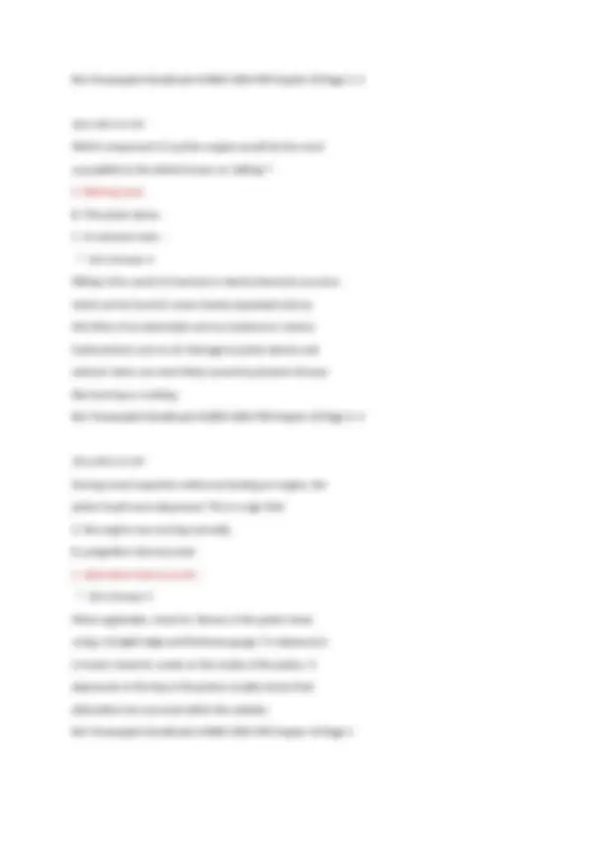
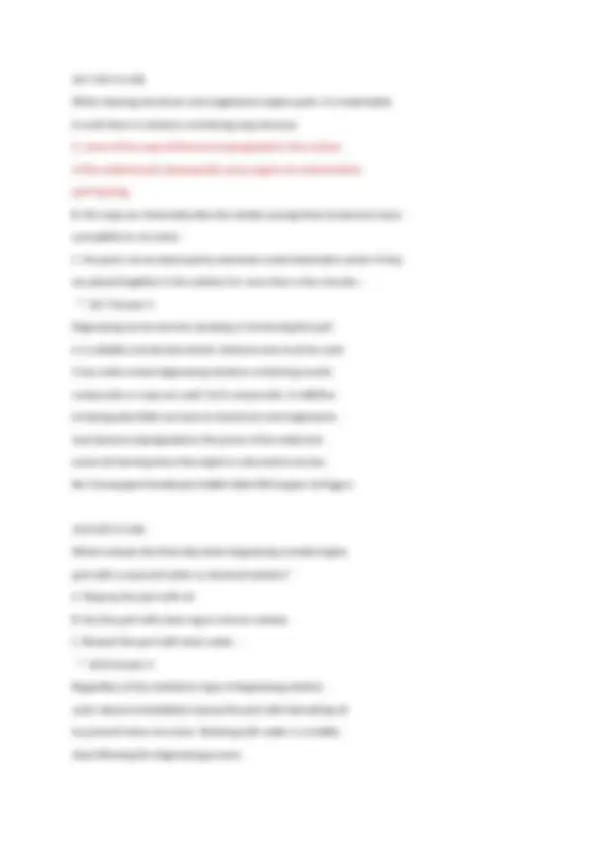

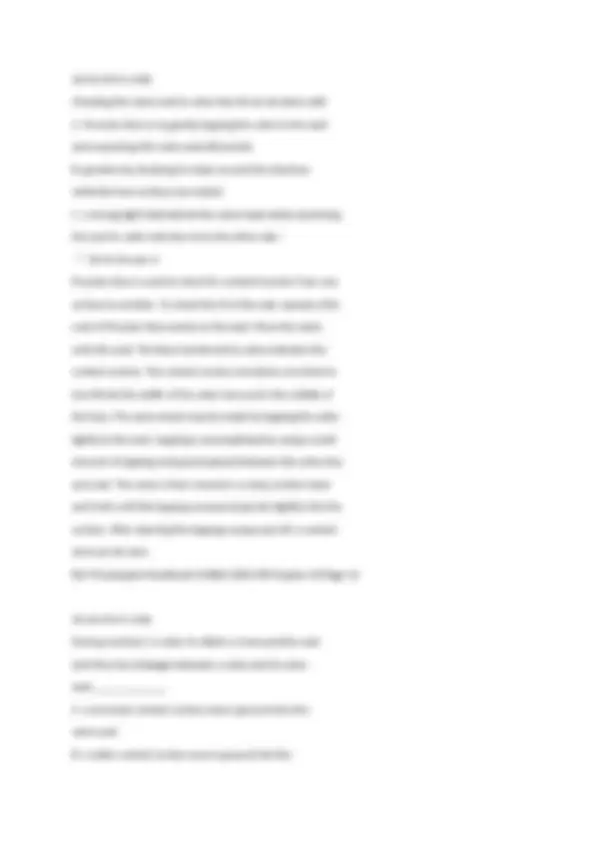
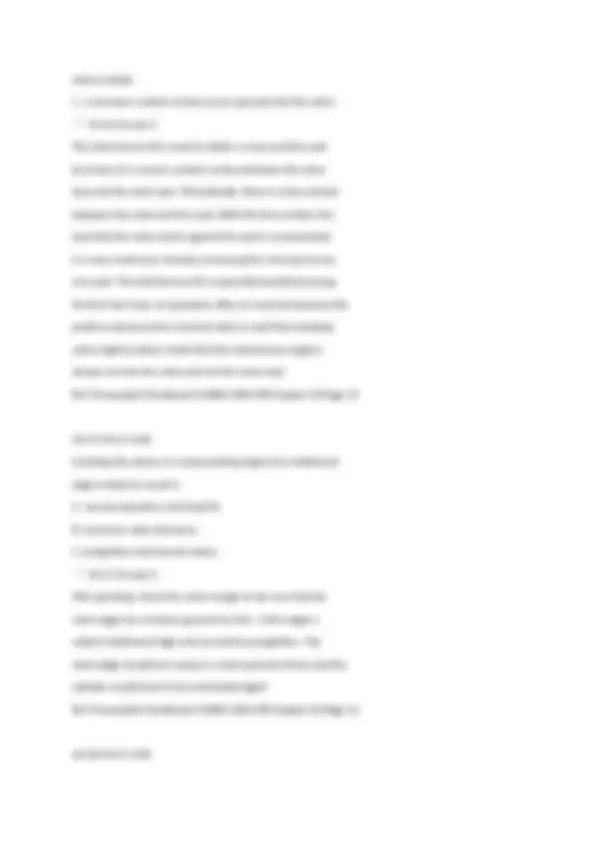
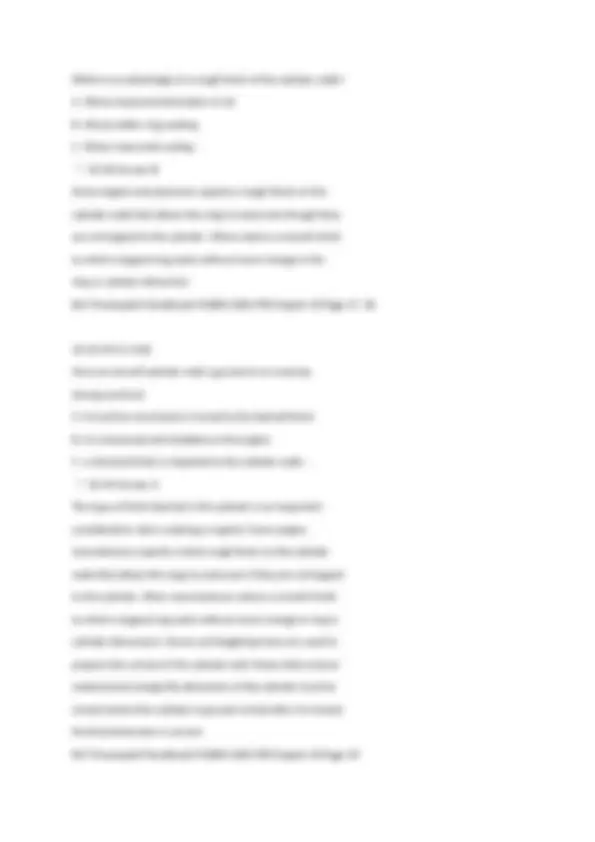
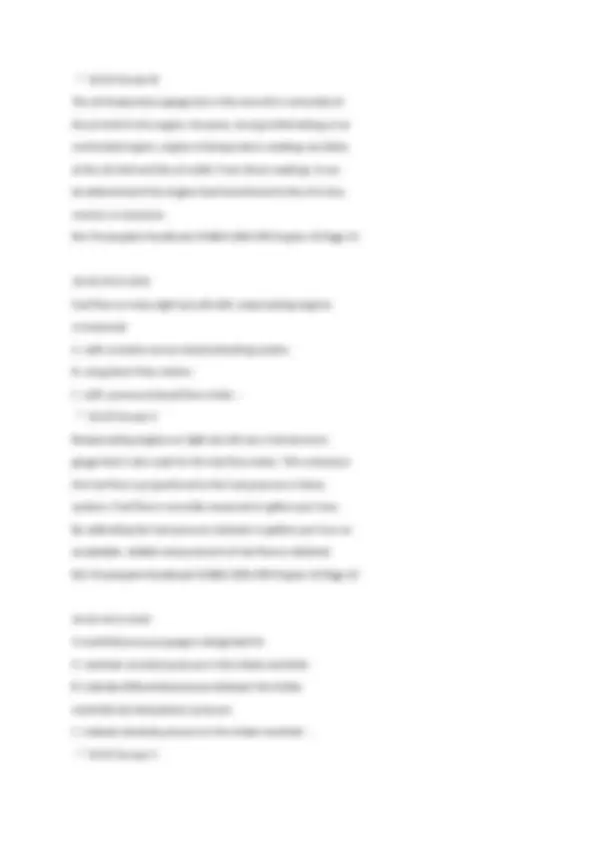
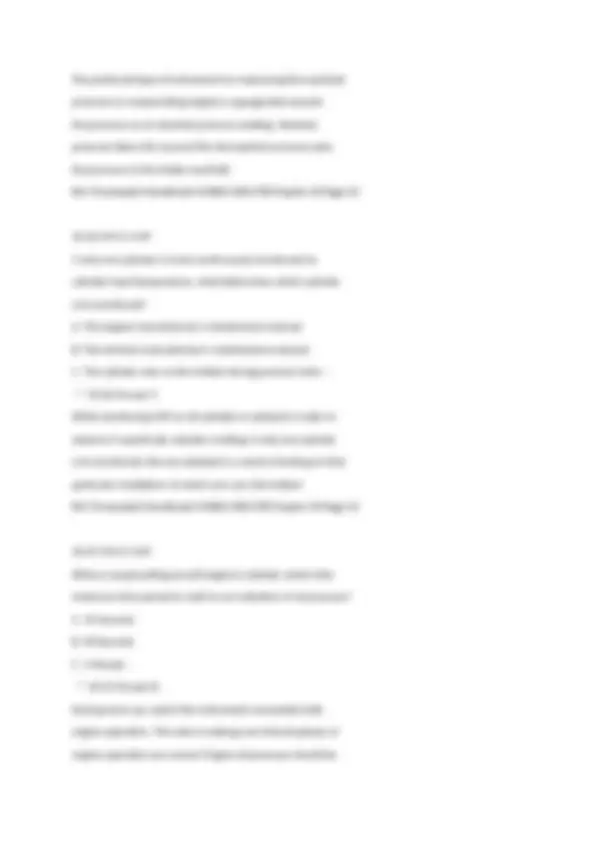
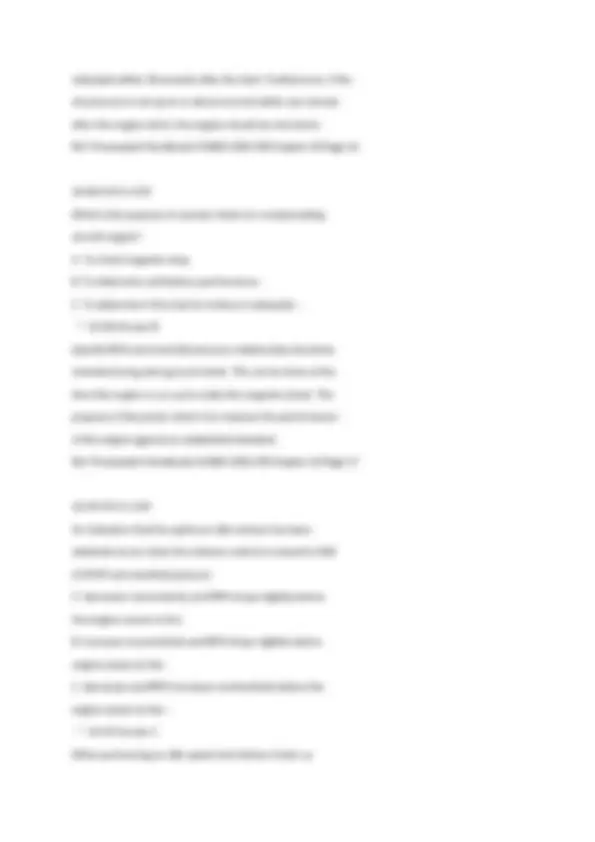
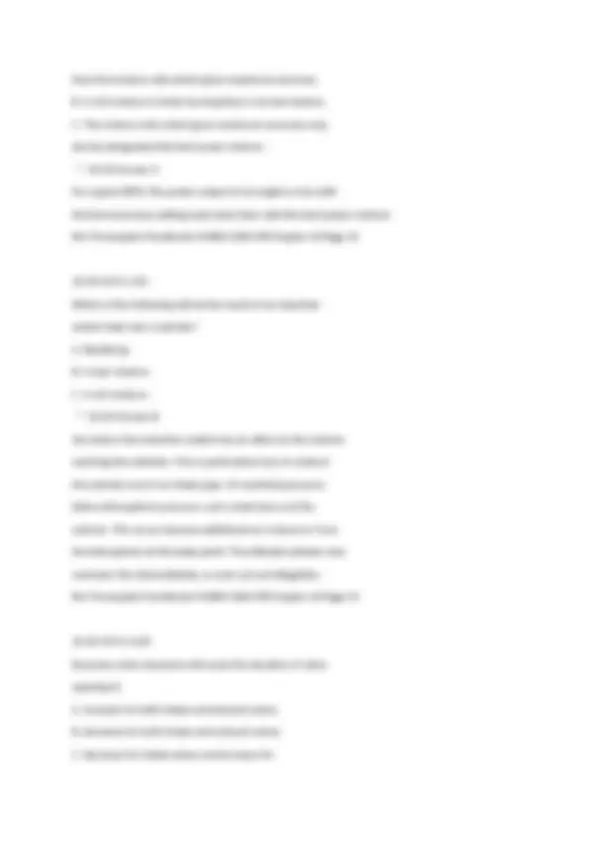
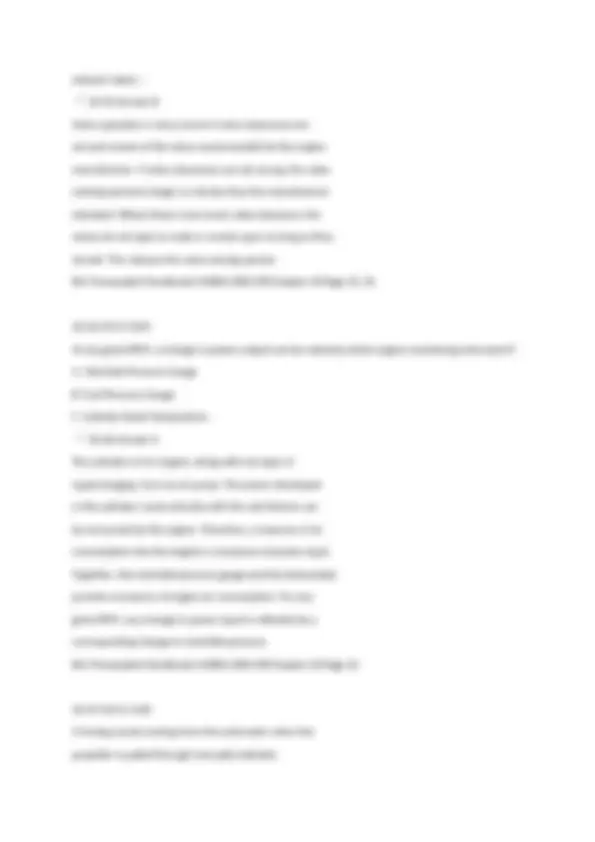
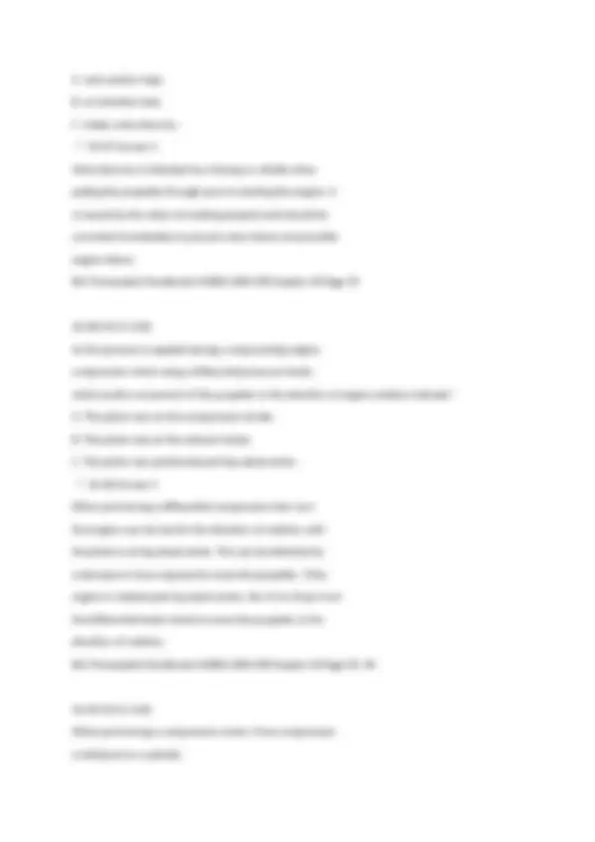
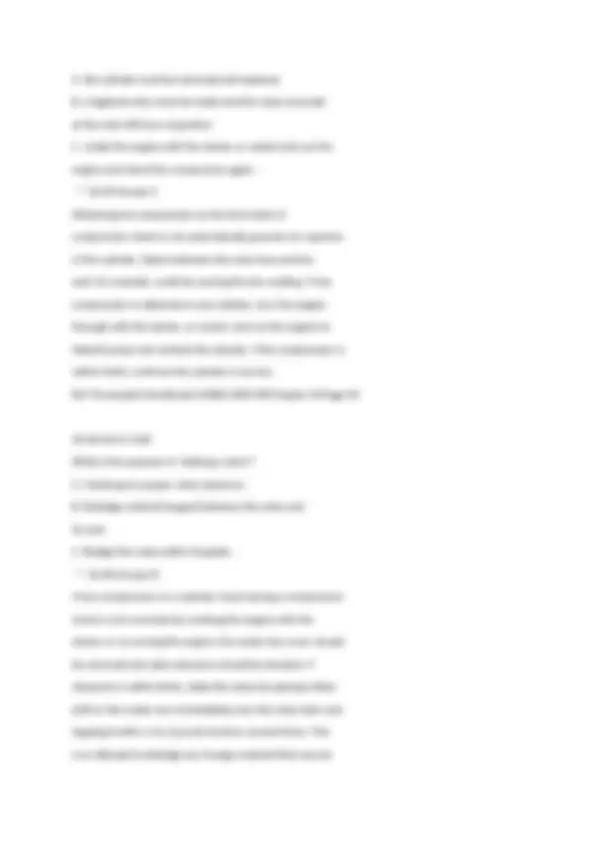
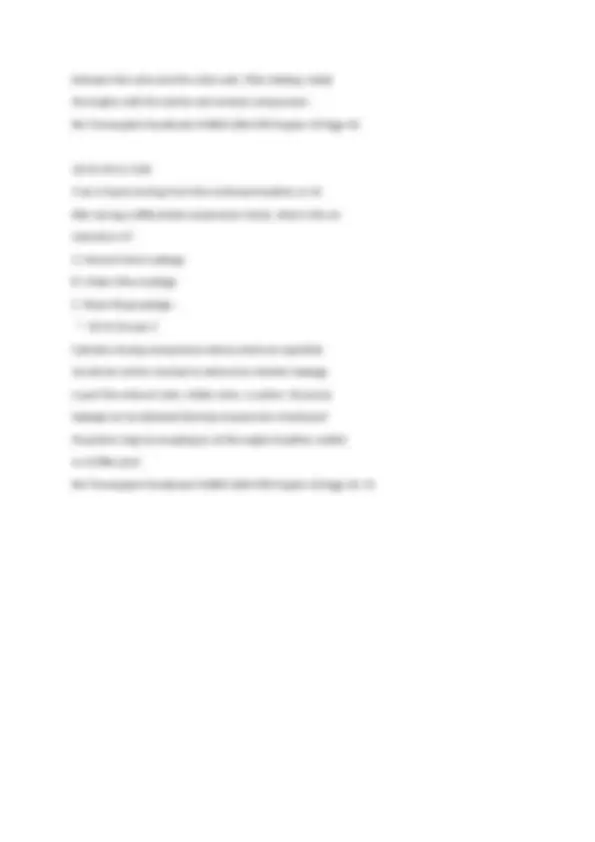


Study with the several resources on Docsity

Earn points by helping other students or get them with a premium plan


Prepare for your exams
Study with the several resources on Docsity

Earn points to download
Earn points by helping other students or get them with a premium plan
Community
Ask the community for help and clear up your study doubts
Discover the best universities in your country according to Docsity users
Free resources
Download our free guides on studying techniques, anxiety management strategies, and thesis advice from Docsity tutors
4th Class Power Engineering Unit B5: Energy Plant Maintenance Study Guide with Practice Questions and Answers
Typology: Exams
1 / 22

This page cannot be seen from the preview
Don't miss anything!















A certified technician with only a powerplant rating may NOT perform or supervise a major overhaul of an engine A. if it is operated for commercial purposes. B. if it has been operated beyond its scheduled TBO time. C. if it is equipped with a supercharger. - ** 10-1 Answer C A certified technician with a powerplant rating may perform or supervise a major engine overhaul in all cases except if the engine contains a supercharger or a propeller reduction system other than with spur type gears. Ref:Powerplant Handbook H-8083-32B-ATB Chapter 10 Page 1 10-2 AM.III.C.K In the sequence tasks to be performed in a major engine overhaul, which is done first? A. Clean the engine. B. Drain all fluids. C. Visually inspect the engine. - ** 10-2 Answer A The first step of an engine overhaul is known as a receiving inspection. This inspection includes a check of all paper work, AD compliance, log books, cleaning of the exterior and mounting it on an overhaul stand. The disassembly process follows which includes draining all fluids, and then followed by a visual, structural (NDT) and dimensional inspection.
Ref: Powerplant Handbook H-8083-32B-ATB Chapter 10 Page 2 10-3 AM.III.C.K Indentations on bearing races caused by high static loads are known as A. fretting. B. brinelling. C. galling. - ** 10-3 Answer B Several terms are used to describe defects detected in engine parts during inspection. One common term is brinelling. Brinelling is one or more indentations on bearing races, usually caused by high static loads or application of force during installation or removal. Indentations are rounded or spherical due to the impression left by the contacting balls or rollers of the bearings. Ref: Powerplant Handbook H-8083-32B-ATB Chapter 10 Page 3 10-4 AM.III.C.K What type of defect is most likely to be found on a ball bearing assembly? A. Burnishing B. Fretting C. Galling - ** 10-4 Answer C Ball bearing assemblies should be inspected for roughness, fat spots, and pitting. In addition the journals should be inspected for galling, scores, and misalignment. Fretting is caused by slight movement in rigidly attached surfaces. Burnishing is resembles polishing caused by movement of surfaces of differing hardness.
When cleaning aluminum and magnesium engine parts, it is inadvisable to soak them in solutions containing soap because A. some of the soap will become impregnated in the surface of the material and subsequently cause engine oil contamination and foaming. B. the soap can chemically alter the metals causing them to become more susceptible to corrosion. C. the parts can be destroyed by dissimilar metal electrolytic action if they are placed together in the solution for more than a few minutes. - ** 10-7 Answer A Degreasing can be done by spraying or immersing the part in a suitable commercial solvent. Extreme care must be used if any water-mixed degreasing solutions containing caustic compounds or soap are used. Such compounds, in addition to being potentially corrosive to aluminum and magnesium, may become impregnated in the pores of the metal and cause oil foaming when the engine is returned to service. Ref: Powerplant Handbook H-8083-32B-ATB Chapter 10 Page 6 10-8 AM.III.A.K What is always the final step when degreasing a metal engine part with a soap and water or chemical solution? A. Respray the part with oil. B. Dry the part with clean rag to remove residue. C. Rewash the part with clean water. - ** 10-8 Answer A Regardless of the method or type of degreasing solution used, always immediately respray the part with lubricating oil to prevent future corrosion. Washing with water is a middle step following the degreasing process.
Ref: Powerplant Handbook H-8083-32B-ATB Chapter 10 Page 6 10-9 AM.III.C.K During inspection, If a rocker shaft is found with a bronze discoloration, what additional component should be inspected? A. The rocker arm tips. B. Alignment of the oil holes. C. The rocker bushing. - ** 10-9 Answer C Rocker shafts are often found to be scored because of excessive turning in the cylinder head. There may be some bronze pickup on the shaft due to abrasion with the rocker bushing. Generally, this is caused by overheating and too little clearance between shaft and bushing. The clearance between the shaft and the bushing is most important. Ref: Powerplant Handbook H-8083-32B-ATB Chapter 10 Page 8 10-10 AM.III.A.K On which part of the cylinder walls of a normally operating engine will the greatest amount of wear occur? A. At the interface of the piston rings. B. Near the top of the cylinder. C. Near the bottom of the cylinder. - ** 10-10 Answer B The cylinder is usually worn larger at the top than at the bottom. At the top of the piston stroke (top of the cylinder), the piston is subjected to greater heat and pressure and more erosive environment than at the bottom of the stroke. Also there is a greater freedom of movement at the top of the stroke. Under these conditions, the piston wears the cylinder
In general, welding of engine parts is A. not acceptable. B. only allowed when approved by the manufacturer. C. can be accomplished if listed in 14 CFR, Part 43. - ** 10-13 Answer B In general, welding of highly-stressed parts can be accomplished only when approved by the manufacturer. However, welding may be accomplished using methods that are approved by the engine manufacturer, and if it can be reasonably expected that the weld repair will not adversely affect the airworthiness of the engine. Ref: Powerplant Handbook H-8083-32B-ATB Chapter 10 Page 12 10-14 AM.III.A.K When overhauling a certified reciprocating aircraft engine A. only steel valve seats can be used. B. new valve seats are required to be installed. C. steel valve seats can be wet or dry grinded. - ** 10-14 Answer C The valve seat inserts of an aircraft engine are usually in need of refacing at engine overhaul. They are refaced to provide a true, clean, and correct size seat for the valve. Steel valve seats are refaced by grinding equipment. It can be either wet or dry valve seat grinding equipment. The wet grinder uses a mixture of soluble oil and water to wash away the chips and to keep the stone and seat cool. This produces a smoother, more accurate job than the dry grinder. The grinding stones may be either silicon carbide or aluminum oxide. Ref: Powerplant Handbook H-8083-32B-ATB Chapter 10 Page 13
Checking the valve seat to valve face fit can be done with A. Prussian blue or by gently lapping the valve to the seat and examining the valve seat afterwards. B. gasoline by checking for leaks around the interface while the two surfaces are mated. C. a strong light held behind the valve head while examining the seat to valve interface from the other side. - ** 10-15 Answer A Prussian blue is used to check for contact transfer from one surface to another. To check the ft of the seat, spread a thin coat of Prussian blue evenly on the seat. Press the valve onto the seat. The blue transferred to valve indicates the contact surface. The contact surface should be one-third to two-thirds the width of the valve face and in the middle of the face. The same check may be made by lapping the valve lightly to the seat. Lapping is accomplished by using a small amount of lapping compound placed between the valve face and seat. The valve is then moved in a rotary motion back and forth until the lapping compound grinds slightly into the surface. After cleaning the lapping compound off, a contact area can be seen. Ref: Powerplant Handbook H-8083-32B-ATB Chapter 10 Page 13 10-16 AM.III.A.K During overhaul, in order to obtain a more positive seal (and thus less leakage) between a valve and its valve seat _____________. A. a narrower contact surface area is ground into the valve seat B. a wider contact surface area is ground into the
Which is an advantage of a rough finish of the cylinder walls? A. Allows improved lubrication of oil. B. Allows better ring seating. C. Allows improved cooling. - ** 10-18 Answer B Some engine manufacturers specify a rough finish on the cylinder walls that allows the rings to seat even though they are not lapped to the cylinder. Others desire a smooth finish to which a lapped ring seats without much change in the ring or cylinder dimension. Ref: Powerplant Handbook H-8083-32B-ATB Chapter 10 Page 17, 18 10-19 AM.III.A.K Once an aircraft cylinder wall is ground to an oversize, during overhaul, A. it must be resurfaced or honed to the desired finish. B. it is measured and installed on the engine. C. a chemical finish is imparted to the cylinder walls. - ** 10-19 Answer A The type of finish desired in the cylinder is an important consideration when ordering a regrind. Some engine manufacturers specify a fairly rough finish on the cylinder walls that allows the rings to seat even if they are not lapped to the cylinder. Other manufacturers desire a smooth finish to which a lapped ring seats without much change in ring or cylinder dimensions. Hones and deglazing hone are used to prepare the surface of the cylinder wall. Hones that remove material and change the dimension of the cylinder must be chosen before the cylinder is ground so that after it is honed the final dimension is correct. Ref: Powerplant Handbook H-8083-32B-ATB Chapter 10 Page 18
After a piston engine is overhauled and reassembled, it must undergo a run-in procedure before being placed into service. What are primary purposes of this procedure? A. Valve seating and crankshaft run-in. B. Seating the piston rings and burnishing the crankshaft bearings. C. Oil pressure leaks, checks, and adjustments. - ** 10-20 Answer B Engine run-in is as vital as any other phase of engine overhaul for it is the means by which the quality of a new or newly overhauled engine is checked and it is the final step in the preparation of an engine for service. Thus, the reliability and potential service life of an engine is in question until it has satisfactorily passed the test cell. The test serves a dual purpose. First, it accomplishes piston ring run-in and bearing burnishing. Second, it provides valuable information that is used to evaluate engine performance and determine engine condition. Ref: Powerplant Handbook H-8083-32B-ATB Chapter 10 Page 19, 20 10-21 AM.III.A.K What should be done In the event of a high carburetor air temperature reading after engine shutdown? A. Fuel lines should be opened. B. The carburetor heat door should be opened. C. The engine should be rotated, (but not started). - ** 10-21 Answer A After shutdown, a high carburetor air temperature is a warning that fuel trapped in the carburetor could expand
** 10-23 Answer B The oil temperature gauge line in the aircraft is connected at the oil inlet to the engine. However, during initial testing of an overhauled engine, engine oil temperature readings are taken at the oil inlet and the oil outlet. From these readings, it can be determined if the engine heat transferred to the oil is low, normal, or excessive. Ref: Powerplant Handbook H-8083-32B-ATB Chapter 10 Page 22 10-24 AM.III.D.K Fuel flow on many light aircraft with reciprocating engines is measured A. with a turbine sensor-based indicating system. B. using direct flow meters. C. with a pressure-based flow meter. - ** 10-24 Answer C Reciprocating engines on light aircraft use a fuel pressure gauge that is also used for the fuel flow meter. This is because the fuel flow is proportional to the fuel pressure in these systems. Fuel flow is normally measured in gallons per hour. By calibrating the fuel pressure indicator in gallons per hour an acceptable, reliable measurement of fuel flow is obtained. Ref: Powerplant Handbook H-8083-32B-ATB Chapter 10 Page 22 10-25 AM.III.D.K A manifold pressure gauge is designated to A. maintain constant pressure in the intake manifold. B. indicate differential pressure between the intake manifold and atmospheric pressure. C. indicate absolute pressure in the intake manifold. - ** 10-25 Answer C
The preferred type of instrument for measuring the manifold pressure on reciprocating engine is a gauge that records the pressure as an absolute pressure reading. Absolute pressure takes into account the atmospheric pressure plus the pressure in the intake manifold. Ref: Powerplant Handbook H-8083-32B-ATB Chapter 10 Page 23 10-26 AM.III.A.K If only one cylinder is to be continuously monitored for cylinder head temperature, what determines which cylinder is to monitored? A. The engine manufacturer's maintenance manual. B. The airframe manufacturer's maintenance manual. C. The cylinder seen as the hottest during previous tests. - ** 10-26 Answer C While monitoring CHT on all cylinders is advised in order to observe if a particular cylinder is failing, if only one cylinder is to monitored, the one selected is a result of testing on that particular installation of which one runs the hottest. Ref: Powerplant Handbook H-8083-32B-ATB Chapter 10 Page 23 10-27 AM.III.A.K When a reciprocating aircraft engine is started, what is the maximum time period to wait for an indication of oil pressure? A. 15 Seconds B. 30 Seconds C. 1 Minute - ** 10-27 Answer B During warm-up, watch the instruments associated with engine operation. This aids in making sure that all phases of engine operation are normal. Engine oil pressure should be
the mixture control lever is moved into IDLE CUTOFF, and before normal drop off, the engine speed may increase. An increase in RPM, but less than that recommended by the manufacturer (usually 20 RPM), indicates proper mixture strength. A greater increase indicates that the mixture is too rich. If the engine speed does not increase or drops immediately when the mixture control lever in moved into IDLE CUTOFF, the mixture is too lean. Ref: Powerplant Handbook H-8083-32B-ATB Chapter 10 Page 28 10-30 AM.III.A.K If detonation in a reciprocating engine is suspected, the correct action is to A. reduce power settings. B. lean the mixture. C. enrichen the mixture. - ** 10-30 Answer C The critical point of detonation varies with the ratio of fuel to air in the mixture and can therefore be controlled by varying the mixture. In general, a rich mixture does not detonate as readily as a lean mixture. Thus, the solution if detonation is suspected is to enrichen the mixture. Ref: Powerplant Handbook H-8083-32B-ATB Chapter 10 Page 29 10-31 AM.III.A.K Which of the following would most likely cause a reciprocating engine to backfire through the induction system at low RPM? A. Idle mixture too rich. B. Clogged derichment valve. C. Lean mixture. -
** 10-31 Answer C When a fuel air mixture does not contain enough fuel to consume all of the oxygen, it is called a lean mixture. An extremely lean mixture either does not burn at all or burns so slowly that combustion is not complete at the end of the exhaust stroke. The fame lingers in the cylinder and then ignites the contents in the intake manifold or the induction system when the intake valve opens. This causes an explosion known as backfiring which can damage the carburetor and other parts of the induction system. Ref: Powerplant Handbook H-8083-32B-ATB Chapter 10 Page 30 10-32 AM.III.A.K One cause of after firing in an aircraft engine is A. an excessively rich mixture. B. an excessively lean mixture. C. sticking intake valve. - ** 10-32 Answer A Overly rich mixtures are also slow burning, therefore charges of unburned fuel are present in the exhaust gases. Air from outside the exhaust stacks mixes with this unburned fuel that ignites. This causes an explosion in the exhaust system. After firing is perhaps more common where long exhaust ducting retains greater amounts of unburned charges. As in the case of back firing, the correction for after firing is the proper adjustment of the fuel/air mixture. Ref: Powerplant Handbook H-8083-32B-ATB Chapter 10 Page 31 10-33 AM.III.I.K Which statement relating to fuel/air ratios is true? A. The mixture ratio which gives the best power is richer
exhaust valves. - ** 10-35 Answer B Valve operation is only correct if valve clearances are set and remain at the value recommended by the engine manufacturer. If valve clearances are set wrong, the valve overlap period is longer or shorter than the manufacturer intended. Where there is too much valve clearance, the valves do not open as wide or remain open as long as they should. This reduces the valve overlap period. Ref: Powerplant Handbook H-8083-32B-ATB Chapter 10 Page 33, 35 10-36 AM.III.D.K At any given RPM, a change in power output can be noted by which engine monitoring instrument? A. Manifold Pressure Gauge B. Fuel Pressure Gauge C. Cylinder Head Temperature - ** 10-36 Answer A The cylinders of an engine, along with any type of supercharging, form an air pump. The power developed in the cylinders varies directly with the rate that air can be consumed by the engine. Therefore, a measure of air consumption into the engine is a measure of power input. Together, the manifold pressure gauge and the tachometer provide a measure of engine air consumption. For any given RPM, any change in power input is reflected by a corresponding change in manifold pressure. Ref: Powerplant Handbook H-8083-32B-ATB Chapter 10 Page 35 10-37 AM.III.A.K A hissing sound coming from the carburetor when the propeller is pulled through manually indicates
A. worn piston rings. B. an induction leak. C. intake valve blow-by. - ** 10-37 Answer C Valve blow-by is indicated by a hissing or whistle when pulling the propeller through prior to starting the engine. It is caused by the valve not seating properly and should be corrected immediately to prevent valve failure and possible engine failure. Ref: Powerplant Handbook H-8083-32B-ATB Chapter 10 Page 39 10-38 AM.III.A.K As the pressure is applied during a reciprocating engine compression check using a differential pressure tester, what would a movement of the propeller in the direction of engine rotation indicate? A. The piston was on the compression stroke. B. The piston was on the exhaust stroke. C. The piston was positioned past top dead center. - ** 10-38 Answer C When performing a differential compression test, turn the engine over by hand in the direction of rotation until the piston is at top dead center. This can be detected by a decrease in force required to move the propeller. If the engine is rotated past top dead center, the 15 to 20 psi from the differential tester tends to move the propeller in the direction of rotation. Ref: Powerplant Handbook H-8083-32B-ATB Chapter 10 Page 39, 40 10-39 AM.III.A.K When performing a compression check, if low compression is obtained on a cylinder,